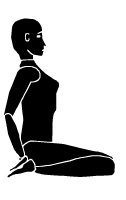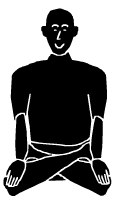Introduction

Human pregnancy lasts about 38 weeks from conception to birth, or 40 weeks from the time of the last menstrual period to birth (a little more than nine months).It is an almost divine fulfillment that she hopes to attain through this act of procreation. Fear and apprehensions often cloud the mind, the moment pregnancy is confirmed. Will I be able to take this responsibility? Will it be a male or a female? Will it be a healthy child? and so on. Child birth is surely the greatest act performed by women. It can be a great emotional experience. The physical and psychological aspects can't be separated. For most of women labour is a time of apprehension of fear and agony. But with a proper antenatal preparation the majority of women can have and labour that is easy and painless or almost painless and she can actually enjoy the labour and experience a sense of fulfillment.
Yoga and Pregnancy
Yoga tackles an individual's well-being on the whole � body, mind and heart. This is very much unlike other forms of physical fitness. Yoga for pregnant women can help would be mother get through their pregnancy with the least amount of discomfort. Pregnancy Yoga even helps in childbirth and in the post-delivery stages. Pregnancy Yoga's stretching exercises help relieve aches and pains. The practices also help improve overall posture and this can help alleviate back problems so common in pregnant women. Smooth pregnancy and a natural childbirth are just some of the benefits of yoga. But more importantly, yoga does wonders on the physical and mental development of the foetus.Ensuring a healthy baby is every woman's dream and yoga helps you do just that. During last few decades, the research in yoga has proved beyond doubts that yoga helps to prevent and cure many chronic ailments. Yogic practices integrate the body, mind and spirit. They bring harmony; develop a restful and positive attitude towards life. This comprehensive programmed of yogic practices designed for pregnant women will help; those to have correct posture flexibility of spine improve their breathing capacity, to manage stress. It helps to build immunity, inner strength, improve control over body and emotions. In short it is the best preventive and curative therapy for many ailments that can occur during pregnancy. It will also ensure the baby's healthy growth.
YOGA POSES FOR PREGNANCY
Butterfly Pose
This pose opens up your hips and inner thighs, and removes tension from the inner thigh area. In addition, it stretches your knees and groin area. It is one of the most beneficial pregnancy poses and if done consistently right from the first trimester, it will almost certainly ease childbirth to a great extent.Squat Pose
This is similar to the position adopted by housecleaners when they sweep the floor, which is why sweeping floors is actually excellent exercise. The squatting posture helps prepare the woman for childbirth, for it is similar to the position she will assume on her back during labor and delivery. This asana should be avoided as soon as the mother experiences the slightest feeling of fatigue.Cat Stretch Pose
This pose strengthens your neck, shoulders and spine, which is why it is also very good for the posture. In addition, it tones up the entire reproductive system, and is very beneficial for women before, during and after pregnancy.Flapping Fish Pose
This pose stimulates digestion and removes constipation. Relaxes nerves of the legs. In later months of pregnancy, lying on the back may cause pressure over major veins and block the circulation. In such circumstances, this posture is ideal for relaxing and sleeping. Also redistributes excess weight around waistline.Thunderbolt Pose
This pose enhances digestive functions and can be practices directly after meals. Relieves stomach ailments like hyperacidity often a trouble faced during pregnancy. Alters blood flow and nervous impulses in the pelvic region and strengthens pelvic muscles. Assists women in labor.Gentle or Gracious Pose
It prevents prostrate enlargement, weakness of the perineal muscles and tones up genital organs. It relieves sciatica and helps strengthen leg muscles. It keeps the uro-genital system in good health. It eases childbirth and alleviates labour pains.YOGA ASANAS FOR PREGNANCY
TADASANA
Tadasana is the foundational posture for all the standing poses. This posture helps maintain your meditative focus, patience and awareness. This is a traditional posture. The final position of this asana resembles the palm tree. Palm tree is usually erect and straight. Therefore, one should stand straight and erect in this asana.
Steps
- Stand erect, legs together, hands by the side of the thighs. Gaze in front.
- Raise your hands straight in front up to arms. Palms facing each other.
- Bring the hands up straight fowards sky, fingers pointing upward.
- Now slowly raise your heels and stand on toes. Raise heels as much as you can. Stretch body up as much as possible.
- While returning to the original position, bring your heels on the ground first.
- Slowly bring down your hands also.
SHAVASANA

Steps
- First of all, you need to sit in the Dandasana. Sit flat on the ground, with your back straight and your legs stretched out in the front.
- Bend you knees lightly and then gradually lean back onto your elbows, in the process lying down evenly along your spine.
- When your back is parallel to the floor, straighten out the legs as well. Moving one of the legs at a time, carefully place them on the floor. Try to place your legs the center of the back of the thighs and calves.
- Start to relax slowly, first letting your feet fall out to the sides and then, turning your arms outwards. Rest the arms, on your sides, in such a way that the palms face up.
- Stretch the back of your neck and try to rest your head on the center of the back of the scull. Now, draw your shoulders away from your ears and let them fall back in a comfortable position.
- Close your eyes and take several deep breaths, feeling your body become relaxed and the tension go away.
- Let go of your body completely and allow your breath to become soft, regular and quiet.
- Aiming at one of the parts of your body, let it begin to relax and then move to the other parts.
- At the end of the asana, stop relaxing consciously and let you body remain in the peaceful mode, for a few minutes.
PASCHIMOTTANASANA

Steps
- This posture involves stretching of the posterior muscles of the body.
- While sitting, stretch your legs forward and keep them close to each other. Bend a little forward, make hooks of your fingers and hold the big toes on the respective sides.
- While exhaling, bend forward stretching the trunk along the thighs. Rest your on the knees, which should be kept straight.
- Gradually, the tense muscles can be made supple for securing the complete posture. Inhale and return to the original position
JANUSIRSASANA

Steps
- Sit on the floor with your buttocks lifted on a folded blanket and your legs straight in front of you. Inhale, bend your right knee, and draw the heel back toward your perineum. Rest your right foot sole lightly against your inner left thigh, and lay the outer right leg on the floor, with the shin at a right angle to the left leg (if your right knee doesn't rest comfortably on the floor, support it with a folded blanket).
- Press your right hand against the inner right groin, where the thigh joins the pelvis, and your left hand on the floor beside the hip. Exhale and turn the torso slightly to the left, lifting the torso as you push down on and ground the inner right thigh. Line up your navel with the middle of the left thigh. You can just stay here, using a strap to help you lengthen the spine evenly, grounding through the sitting bones.
- When you are ready, you can drop the strap and reach out with your right hand to take the inner left foot, thumb on the sole. Inhale and lift the front torso, pressing the top of the left thigh into the floor and extending actively through the left heel. Use the pressure of the left hand on the floor to increase the twist to the left. Then reach your left hand to the outside of the foot. With the arms fully extended, lengthen the front torso from the pubis to the top of the sternum.
- Exhale and extend forward from the groins, not the hips. Be sure not to pull yourself forcefully into the forward bend, hunching the back and shortening the front torso. As you descend, bend your elbows out to the sides and lift them away from the floor.
- Lengthen forward into a comfortable stretch. The lower belly should touch the thighs first, the head last. Stay in the pose anywhere from 1 to 3 minutes. Come up with an inhalation and repeat the instructions with the legs reversed for the same length of time.
VAJRASANA

Steps
- With knees, ankles and big toes touching the ground, take a kneeling position.
- One should sit on the heels and place palms on the knees.
- The Spine should be erect and breath should be deep.
- Draw the abdominal region inside and expand the chest.
PADMASANA

Steps
- For padmasana sit in the Dandasana (staff pose) with spine straight and legs extended in front of you.
- Then fold the right knee, put the right ankle on to the left thigh, and then pulls the left ankle over the folded right leg and places it on the right thigh.
- Take hold of both feet and ease them further in toward your groin, aiming for a balanced, symmetrical position.
- The head, neck and spine must be straight in Padmasana. Place the hands on the knees with the fingers depicting the holy sign, as in Chin or Jnana Mudra.
- Close the eyes and concentrate on your normal breathing. Sit in this posture as long as you can.
PRANAYAMA
Pranayama or Breathing Exercise which promotes proper breathing. In a Yogic point of view, proper breathing is to bring more oxygen to the blood and to the brain, and to control Prana or the vital life energy. Pranayama Yoga also goes hand in hand with the Asanas. The union of these two Yogic Principles is considered as the highest form of purification and self-discipline, covering both mind and body.
Diseases Related to Scorpio |
||


